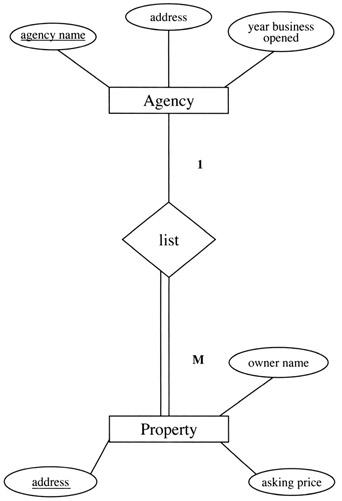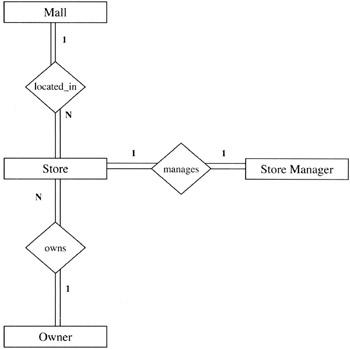
Моделирование бизнес-процессов / Моделирование бизнес-процессов / ER-диаграмы / 0849315484 Entity-Relationship Diagrams
.pdfChapter 4 Exercises
Exercise 4.1
Refer to Figure 2.3. Suppose that the only attributes of STUDENT are student number and name. And, let us suppose that we have another entity called "high school," which is going to be the high school from which the student graduated. For the high school entity, we will record the high school name and the location (meaning city and state). Draw the ER diagrams using the Chen-like model. Follow the methodology and include all English descriptions of your diagrams. Map the ER diagrams to a relational database.
Exercise 4.2
Suppose that a college has one dormitory with many rooms. The dormitory entity, which is actually a "dormitory room" entity because there is only one dorm, has the attributes room number and single/double (meaning that there are private rooms and double rooms). Let us suppose that the STUDENT entity in this case contains the attributes student number, student name, and home telephone number. Draw the ER diagrams using the Chen-like model. Follow the methodology and include all English descriptions of your diagrams. Map the ER diagrams to a relational database.
Exercise 4.3
Consider a student database with students and campus organizations. Students will have the attributes of student number and student name. Organizations will have the following attributes: organization name and organization type. Draw the ER diagrams using the Chen-like model. Follow the methodology and include all English descriptions of your diagrams. Map the ER diagram to a relational database and include some sample data.
Exercise 4.4
Consider a student and advisor database. Students have a student number and student name. Advisors have names, office numbers, and advise in some major. The major that the advisor advises in is designated by a major code (e.g., Chemistry, CHEM; Biology, BIOL; Computer Science, COMPSC: etc.) Draw the ER diagrams using the Chen-like model. Follow the methodology and include all English descriptions of your diagrams. Map the ER diagram to a relational database and include some sample data.
Exercise 4.5
You want to record the following data in a database: restaurant name and location, employee names and IDs, capacity of restaurant (smoking and nonsmoking), hours of operation (assume same hours every day), employee salaries and titles. An employee can work for only one restaurant. Draw the ER diagrams using the Chen-like model. Follow the methodology and include all English descriptions of your diagrams. Map the ER diagram to a relational database and include some sample data.
Exercise 4.6
Record the following data in a database: business name, owner, location(s),

telephone #(s), delivery truck number, truck capacity, usual route description (e.g., North, West, Central, Lake). Draw the ER diagrams using the Chenlike model. Follow the methodology and include all English descriptions of your diagrams.
Exercise 4.7
Refer to Figure 4.10. What are the English language statements you can make about the figure?
Figure 4.10
Exercise 4.8
Refer to Figure 4.9. Complete the diagram by adding a precise English description of each attribute. Map Figure 4.9 to a relational database.
Exercise 4.9
What is the cardinality of the following?
a.Each student can have only one car
b.Each student has many cars
c.Each car can be driven by many students
d.Each car must be driven by many students.
Which of these above cardinality rules are optional? Which rules are mandatory? Diagramatically show these relationships.
References
Batani, C., Ceri, S., and Navathe, S.B., Conceptual Database Design. Benjamin/Cummings Publishing, Redwood City, CA, 1992.
Earp, R. and Bagui, S., "Extending Relationships in the Entity Relationship Diagram," Data Base Management, Auerbach Publications, Boca Raton, FL, 22-10-42, 1-14, May 2001.
Elmasri, R. and Navathe, S.B., Fundamentals of Database Systems, 3rd ed., Addison-Wesley, Reading, MA, 2000.
Kroenke, D.M., Database Processing, Prentice Hall, Upper Saddle River, NJ, 2000.
McFadden, F.R. and Hoffer, J.A., Modern Database Management, 4th ed., Benjamin/Cummings Publishing, Redwood City, CA. 1994.
Ramakrishnan, R. and Gehrke, J., Database Management Systems, 3rd ed., McGraw-Hill, New York, 2003.
Sanders, L., Data Modeling, Boyd & Fraser Publishing, Danvers, MA, 1995.

Case Study: West Florida Mall (continued)
In the past few chapters we selected our primary entities (as per the specifications from the user so far) and defined the relationships between the primary entities. In this chapter we proceed with the ER diagram for this case study by looking at steps 6 and 7 of the ER design methodology, and map the ER diagram to a relational database (with some sample data) as we proceed.
Step 6 develops the structural constraints of binary relationship by stating:
Step 6: State the exact nature of the relationships in structured English from all sides. For Example, if a relationship is A:B::1:M, then there is a relationship from A(1) to B(M) and from B(M) back to A(1).
Refer to Figure 4.11.
Figure 4.11: An ER Diagram of West Florida Mall with Four Entities and Structural Constraints
First, for the relationship located_in:
From MALL to STORE, this fits Pattern 3, 1(full):N:
One mall must have many (at least one) stores.
or
Malls, which are recorded in the database, must have many (one or more) stores located in them.
From STORE to MALL, this fits Pattern 1, M(full):1:
Many stores (one or more) must be in one mall.

or
Stores, which are recorded in the database, must be in one mall.
To map this relationship (with some sample data):
The MALL entity will be mapped as was shown in the case study in Chapters 2 and 3 (as shown on the following page):
MALL-Store
name |
store_name |
|
|
|
|
West Florida Mall |
Penney's |
|
West Florida Mall |
Sears |
|
West Florida Mall |
Dollar Store |
|
West Florida Mall |
Rex |
|
Cordova Mall |
Dillards |
|
|
MALL |
|
|
|
|
name |
address |
|
|
|
|
West Florida Mall |
N Davis Hwy, Pensacola, FL |
|
Cordova Mall |
9th Avenue, Pensacola, FL |
|
Navy Mall |
Navy Blvd, Pensacola, FL |
|
BelAir Mall |
10th Avenue, Mobile, AL |
|
Next, we have to map the relationship between the MALL entity and the STORE entity. This is a binary 1:N relationship; hence, we will use mapping rule M3c_1, which states:
M3c_1 — For binary 1:N relationships, if the N-side has full participation, include the key of the entity from the 1 side, in the relation on the N side as a foreign key.
So, the key from the 1 side, the MALL side, name (meaning, mall_name), will be included in the N side, STORE side, as the foreign key, as follows:
STORE
sloc |
sname |
snum |
mall_name |
|
|
|
|
Rm 101 |
Penney's |
1 |
West Florida Mall |
Rm 102 |
Sears |
2 |
West Florida Mall |
Rm 109 |
Dollar Store |
3 |
West Florida Mall |

Rm 110 |
Rex |
4 |
West Florida Mall |
Due to the multi-valued attribute, depts, in STORE, we will keep the relation with the multi-valued attribute (as developed in Chapter 3):
STORE-dept
snum depts
1 Tall men's clothing
1 Women's clothing
1 Children's clothing
1 Men's clothing
.
.
.
Then, for the relationship owns:
From OWNER to STORE, this fits Pattern 3, 1(full):M:
Owners, which are recorded in the database, must own one or more stores.
or
One owner must own at least one store, and may own many stores.
From STORE to OWNER, this fits Pattern 1, M(full):1:
Stores, which are recorded in the database, must have one and only one owner.
or
Many stores can have one owner.
To map this relationship (with some sample data):
For the relationship owns, from OWNER to STORE, a 1:N relationship:
Again, using mapping rule M3c_1, we will take the key from the 1 side, so_ssn, and include this as the foreign key in the N side, STORE, so STORE now becomes:
STORE
sloc |
sname |
snum |
mall_name |
so_ssn |
|
|
|
|
|
Rm 101 |
Penney's |
1 |
West Florida Mall 879-987-0987 |

Rm 102 |
Sears |
2 |
West Florida Mall |
928-088-7654 |
Rm 109 |
Dollar Store |
3 |
West Florida Mall |
826-098-0877 |
Rm 110 |
Rex |
4 |
West Florida Mall |
982-876-8766 |
And the relation for the OWNER entity remains as developed in the earlier chapter:
OWNER
so_ssn |
so_name so_off_phone |
so_address |
|
|
|
|
|
879-987- |
Earp |
(850)474-2093 |
1195 Gulf Breeze Pkwy, |
0987 |
|
|
Pensacola, FL |
826-098- |
Sardar |
(850)474-9873 |
109 Navy Blvd, |
0877 |
|
|
Pensacola, FL |
928-088- |
Bagui |
(850)474-9382 |
89 Highland Heights, |
7654 |
|
|
Tampa, FL |
982-876- |
Bush |
(850)474-9283 |
987 Middle Tree, Mobile, |
8766 |
|
|
AL |
Next, for the relationship, manages:
From STORE to STORE MANAGER, this fits Pattern 1, 1(full):1:
Stores, which are recorded in the database, must have one store manager.
or
Stores must have one store manager, and can only have one and only store manager.
From STORE MANAGER to STORE, this also fits Pattern 1, 1(full):1:
Store managers, which are recorded in the database, must manage one and only one store.
or
Store managers must manage at least one store, and can manage only one store.
To map this relationship (with some sample data):
The relationship between STORE and STORE MANAGER is a binary 1:1 relationship, hence using mapping rule M3b_3, the relation STORE would develop into (we are taking the key from STORE MANAGER, sm_ssn, and including it in STORE as the foreign key):
STORE
sloc |
sname |
snum mall_name |
so_ssn |
sm_ssn |

Rm |
Penney's |
1 |
West Florida |
879-987- |
283-972- |
101 |
|
|
Mall |
0987 |
0927 |
Rm |
Sears |
2 |
West Florida |
928-088- |
456-098- |
102 |
|
|
Mall |
7654 |
0987 |
Rm |
Dollar |
3 |
West Florida |
826-098- |
234-987- |
109 |
Store |
|
Mall |
0877 |
0988 |
Rm |
Rex |
4 |
West Florida |
982-876- |
928-982- |
110 |
|
|
Mall |
8766 |
9882 |
And the relation for the STORE MANAGER entity remains as was developed in the earlier chapter:
STORE MANAGER
sm_ssn |
sm_name |
sm_salary |
|
|
|
234-987-0988 |
Saha |
45,900 |
456-098-0987 |
Becker |
43,989 |
928-982-9882 |
Ford |
44,000 |
283-972-0927 |
Raja |
38,988 |
Our next step will be step 7, which is:
Step 7: Present the "as-designed" database to the user, complete with the English for entities, attributes, keys, and relationships. Refine the diagram as necessary.
In summary our relational database has so far been mapped to (without the data): (Note: The primary keys are underlined.)
MALL-Store
name store_name
MALL
name address
STORE
sloc sname snum mall_name so_ssn sm_ssn
STORE-dept
snum depts
OWNER
so_ssn so_name so_off_phone so_address
STORE MANAGER

 sm_ssn sm_name sm_salary
sm_ssn sm_name sm_salary
We continue with the development of this case study at the end of Chapter 5.
